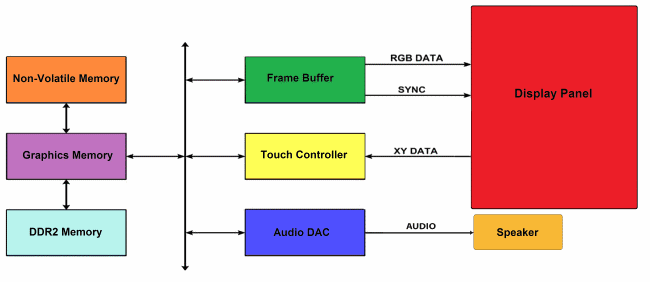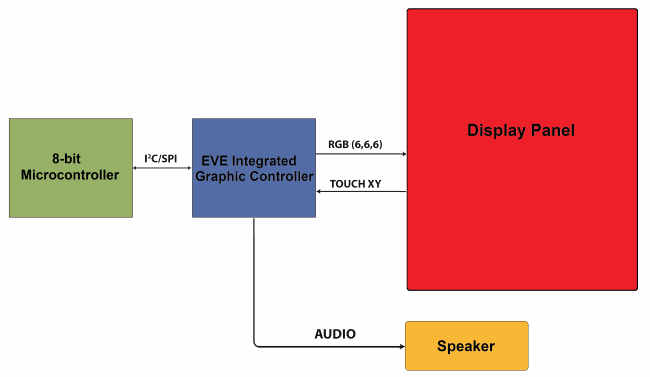By GORDON LUNN, Engineering Support Manager
FTDI Chip,
www.ftdichip.com
The human machine interface (HMI) recognized as a key part of electronics design and uptake of touch-based HMIs have been something of a phenomenon. Why exactly is that?; what does touch bring that alternative methods could not?
Well, basically, HMIs provide a highly effective way for us to interact with modern technology. Through properly orchestrated HMIs, better user experiences can be derived — leading to more intuitive and efficient control processes for all manner of electronics equipment. Thanks to the mounting utilization of touchscreen technology over the last decade, the HMI has proven to be a principal route through which manufacturers can differentiate their products.
Can the HMI help determine whether a product is a success or a failure?
Increasingly, this is definitely the case. If the HMI that is built into a product is poorly realized, then it is going to have a detrimental effect on that product’s operation. This will be of annoyance to the user and could mean that the product is less likely to thrive in the long term, with other options being seen as more appealing. So not putting enough thought into the HMI aspect of an electronic system’s design can be potentially disastrous.
What dynamics are currently influencing the HMI business?
New opportunities for touch-based HMIs are opening up all the time. They are already commonplace, if not ubiquitous, in consumer goods (such as smartphones, MP3 players, and tablets). There are, however, still plenty of new prospects in currently underserved areas — such as industrial control, retail, medical, and countless others. Having gotten used to touch-based manipulation in certain aspects of our daily lives, everyone is now keen to apply this across the board — taking in all the other activities, too.
In industrial application scenarios (like factory production lines), touch-based HMIs can help to ramp up productivity levels, as control operations can be carried out at an accelerated pace. Besides boosting output (and therefore profitability), other financial benefits should be noted, too. Use of this kind of technology means that users generally do not need as much training because the machinery they are using will be simpler to control. For example, in the medical sector, touch-based HMIs allow greater access to information, so decisions concerning what will be the appropriate treatment can be reached more quickly and more accurate diagnoses can be made. Mitigating user frustration is another plus point. For example, advances are now being made to home automation systems, which will become more popular over the next few years. As a consequence, there will be a need to move away from the eight-segment linear displays and rudimentary keypads that were used in the past to operate boilers and security alarms. These were already very problematic to manipulate, and with additional functionality and more data to deal with, the level of difficulty would be pushed even further. Through touch-based HMIs, greater flexibility will be beneficial because control panels of vending machines or industrial systems can be updated without having to change the core mechanisms of the system; it can be done by just altering the APIs. With all of this in mind, TechNavio has forecast that the global touchscreen market will experience a compound annual growth rate (CAGR) of about 5.50% between now and the end of the decade. Applications outside the consumer sphere, such as those already mentioned, will contribute heavily to this growth. Moving forward, standard touch systems will no longer be enough. More is going to be expected in terms of the features and functionality that will be included.
Can you give some specifics about the areas in which increasing display size will be advantageous?
Utilization of touchscreens that support the migration to larger-format displays with greater color depth will be paramount. Via these larger displays, more detailed images (and potentially video content) may then be accessed, thereby raising user satisfaction. The resulting touch-enabled HMIs will need to offer higher touch sensor resolutions and, in most cases, have the capacity to deliver multi-touch operation. Video playback is another attribute that will be valued in the future. Display rotation will become more important in various forms of handheld apparatus (following the trend led by consumer devices) — such as RFID scanners, field test equipment, and meter readers.
So what is driving demand for multi-touch operation?
The ability to simultaneously determine multiple touch points is proving highly advantageous across a broad cross-section of applications, with the upshot that complex gestures can be distinguished. Using such functionality, items rendered on the display can be resized using a two-digit stretch/shrink gesture or their orientation changed via a multi-finger rotate gesture. This sort of thing is already commonplace in portable consumer goods, of course, but there is no reason for it to remain confined to that area.
Specifically, which applications are likely to benefit from video playback?
There are numerous places where the use of video content will be of real value. Short, animated films can be played on the built-in displays of equipment to help users learn how to operate them. In an office environment, this could be in reference to removing paper jams from printers/photocopiers; in hotels, guests could be shown how to use the self-service coffee machine. In restaurants, videos could help give customers details of the specials on offer, whereas in a retail context, short clips could be shown in the elevators of department stores — informing shoppers, upon arrival at each floor, which products are to be found there. In the home, simple animation (see video) could be employed on washing machine HMIs to let the user know what stage of the wash cycle has been reached.
In the home, simple animation could be used on washing machine HMIs to convey to the user what stage of the wash cycle has been reached.
Where is there interest in these more advanced HMIs?
OEMs covering a range of industry sectors are looking to raise the bar in terms of the HMIs that are incorporated into their products. These include everything from domestic appliances, metering systems, and point-of-sales units to building automation systems, test instrumentation, and vending machines.
What are the implications for the semiconductor industry?
All of this presents some pretty serious challenges for the manufacturers of related IC technology. They are under a lot of pressure to introduce solutions that can meet the increasing performance required to create more sophisticated HMIs with a greater breadth of functionality. To complicate matters, numerous board-level issues must be tackled, such as ensuring the component count remains as low as possible (to save board space and limit bill-of-materials costs), minimizing power consumption, and keeping development periods brief to accelerate time-to-market.
How is FTDI responding to these issues?
The engineering team at FTDI recognized early on that the conventional way of implementing HMIs (see Fig. 1 ) was starting to prove inadequate and, over time, the gap between what was desired and what could actually be delivered would continue to widen unless something was done to address this. As a result, we were driven to develop a new approach to HMI implantation, based on an object-oriented topology. This culminated in the introduction of the Embedded Video Engine (EVE) series of graphic controller ICs.

Fig. 1: The conventional way of implementing HMIs is no longer adequate.
What differentiates EVE from other HMI solutions?
Using EVE devices, the silicon overhead needed to create effective HMIs can be reduced substantially, with the display, touch, and audio elements all being addressed in a single chip (see Fig. 2 ). Basically, EVE’s object-oriented approach works like this. The image content (and audio content) needed for the HMI is treated as a collection of objects with pre-defined characteristics. Objects can be images, text fonts, templates, and overlays, as well as sounds (such as beeps or chirps). Instead of complex items (each made up of many pixels), which are difficult to render, EVE images can be rendered line by line. This means that the large flash memory that would normally be required, plus the frame buffer and wide parallel buses needed to support it, can be eliminated from the system design.

Fig. 2: Using the embedded video engine (EVE) devices, the silicon overhead needed to create effective HMIs can be reduced substantially, with the display, touch, and audio elements integrated into a single chip.
The original FT80x offering has been expanded with the introduction of our second-generation EVE devices — the FT81x series. This series has taken the technology further, enabling larger displays (7 in. and above) with higher resolutions (800 x 600-pixel formats) supported. Algorithm enhancements permit smoother video playback. Another useful function that has been added is screen rotation. This facilitates the turning of display content through 90° so the user can switch between landscape and portrait orientations as required. The object-oriented methodology that EVE follows lends itself very well to dealing with animated content. As displayed images are simply thought of as objects, rendering movement is accomplished by continuously updating an object’s coordinates, rather than having to redraw the whole image each time the display refreshes. In addition, objects can be repeated in different locations, without the need to create additional content that will impact the system’s memory resource.
Based in Glasgow (Scotland), Gordon Lunn is FTDI Chip’s Global Customer Engineering Support Manager. He has spent 11 years with the company. He graduated from Heriot Watt University with a BEng (Hons) in Electrical & Electronic Engineering. Gordon used to work in digital design for Racal Defense and IndigoVision.
Advertisement





